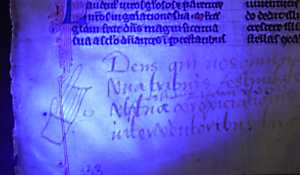| The recto of the page, at the foot, contains an annotation, complete with a little pointing hand, as is so often found in scholarly medieval texts as notes and glosses were added to them. The ink is very faded and it is not possible to read it properly, even with a magnifying glass or some digital jiggerypokery to enhance the contrast. However, it would appear that the writing is no earlier than the 16th century, and very possibly later. |
 |
| One of the tricks of the paleography trade involves the use of ultra-violet light. When UV light is shone on to parchment, it fluoresces, but even a tiny trace of ink blocks this fluorescence. Putting a parchment with faded ink under a UV light can make very faded writing show up clearly. Now I don't actually have a fancy UV reading light, but I did manage to buy from a science shop a $10 invisible writing kit for kids which included a small UV torch. I passed this over the practically invisible text and lo and behold, it was all legible. Showing this to you has involved some ingenuity, hiding on the floor in the dark behind a chair with a UV torch in one hand and a small digital camera in the other, trying to actually capture the effect, but here goes! The camera was inclined to be tricked by the UV and my old hands tend to shake, but I managed one decent image. |
 |
It is not possible to show you the whole text in one photograph, as my eccentric equipment required me to track backwards and forwards with the little torch, but you can see the effect. Unfortunately the text is chopped off on the right hand side, indicating that it must have been written at some time before the book was trimmed for rebinding. What is left reads as follows (I think): |
Deus qui nos omnium sanctoru[m] solemn..... Una tribuis festiuitate uenerari concede..... [two illegible words] vobis Ultra propiciationis effectum multi.....
Interuentoribus largiares |
| The line with the two illegible words is inserted as very tiny writing between the main lines; a gloss within a gloss. Having done that bit of detective work, I guess the next question is what is that all about, and why did somebody centuries later think it was sufficiently important to write it there? |
 back to main text back to main text |
| Bible, c.1260. From a private collection. Photographs © Dianne Tillotson. |
|
|
overview | initials and headers | text
| alphabet | abbreviations
| exercises | transcript
| translation
| |
|
Click
on each of the above to walk your way through the text. The transcript
will appear in a separate window so that you can use it for reference
at any time. These exercises are designed to guide you through the text,
not test you, so you can cheat as much as you like. |
|
 Script sample for this example Script sample for this example |
 Index
of Exercises Index
of Exercises |
 Index
of Scripts Index
of Scripts |
|
 |
 |

